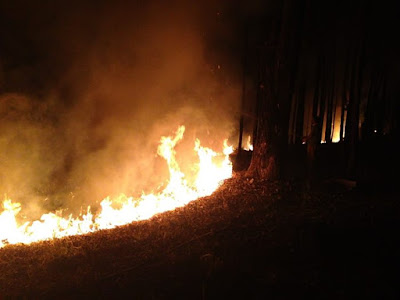Fire at
Possum Valley is an ever present threat throughout the warmer months. Over
15 acres of the property is covered in thick jarrah forest, providing homes and
food for both local wildlife and those in care. Whilst privileged to have
this resource literally on the doorstep, with it comes the responsibility of
ensuring animals at the Sanctuary are safe should a fire eventuate.
 |
| 'Burning off' to prevent bushfire threat. |
Managing
the risk of fire is a priority throughout the year. With summer comes the
cleaning and stockpiling of carriers and cages and the servicing of trailers
and floats, ready to house and move residents in an evacuation. Such an
evacuation would need time and is only possible with sufficient warning.
Special care needs to be taken to minimize animal stress during a potential
evacuation, keeping them cool, quiet and calm.
Clearing
around aviaries, enclosures and paddocks is undertaken annually to minimise
radiant heat if a fire takes hold. Huge piles of material are burnt
throughout the winter months to reduce fire risk. While the Sanctuary
favours native plantings, flammable trees such as eucalypts, overhanging
aviaries and lining paddocks, are pruned or replaced with introduced,
non-flammable species including poplars, maples and fruit trees. An
article on ‘fire-safe’ plantings will feature this Spring.
 |
| Areas around the buildings are cleared and re-planted. |
Reticulation,
set on a timer, is run around and above all animal enclosures. Throughout the
summer months, it doubles to cool animals and keep the environment damp
should a fire approach. A specially designed woven cloth shipped from
Queensland covers enclosures, providing shade while also protecting from embers that may catch alight. Possums in pre-release care are provided with
bags within their nest boxes, allowing them to be easily scooped and brought to
safety from their pre-release aviaries in an emergency. Nets are located
with the bird aviaries in readiness for their capture. Birds are very
sensitive to smoke, with their delicate lungs at risk of smoke inhalation, so
evacuation for our avian friends is at the top of the evacuation list.
 |
| Aviary with fire retardant woven cloth. |
Long grass
is mowed or selectively grazed and paddocks are consciously overgrazed on the
approach of summer to ensure large animals have safe refuge from ground
fire. Whilst hooves appear quite tough, the soft pads which they cover
can suffer badly from even small grass fires and hot ground. It is
important that paddock animals have clear room to move in a fire, so on high
fire danger days, animal locations are strategically planned to ensure this
requirement is met.
In addition
to property preparation, a fire trailer and fire unit are on site throughout
the year, assisting in controlled burning and also in fire response should it
be required. A buffer strip protecting the house and animal accommodation
is burnt annually during the burning season or following approval for a permit to burn. Care is taken not to injure native wildlife during controlled burns, with leaf
litter checked for bobtails and other native neighbours while setting alight
these areas.
Lastly, a
detailed fire response plan is printed each year, ensuring all animals are
accounted for in emergency. Where possible, animals would ideally be
evacuated to safety with any threat of fire, with the above preparations being
implemented only in the case of a sudden fire when time is limited.
 |
| 'Burning off' on a cool evening. |


No comments:
Post a Comment